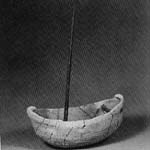Ur harbour, 2100 BC
In this depiction of the Harbor at Ur, we notice that the boat's
sails are quite a prominent feature.
The question of the use of Sails in Mesopotamia is a fairly obscure
one, although some scholars
have made careful comments; evidence for the use of sails is hard
to come by
(perhaps due to the parishable nature of the material) however
there are occasional indicators
that are infrequently alluded to, for example S.N. Kramer (1969,
p.104) explains that:
"Transportation by boat was quite feasible and economical,
and one boat of
a little over five register tons could haul as heavy a load as
a hundred minas. There
were also very large boats constructed in special shipyards, and
these were no doubt used
for long sea voyages to such lands as Meluhha and Dilmun. The
common boat in use was the
one known today in Iraq as the guffa and in ancient times as "the
turnip"; it was made of
reeds, covered with skin, and shaped like a basket. The sailboat,
too, was probably known
in ancient Sumer, to judge from a model of a boat found in Eridu.
Oars and punting poles
were in common use from early times. Along the river banks, however,
the boats were
were often pulled by men or oxen.

That boats were used to haul timber (as may be suggested by the
timber piled on
the dock in this painting) is attested in numerous texts and literary
sources
such as the lines from "Enki and the World Order" which
read: ""I will admire its green
cedars. Let the lands of Melu?a, Magan and Dilmun look upon me,
upon Enki. Let the Dilmun
boats be loaded (?) with timber. Let the Magan boats be loaded
sky-high. "
An example from the epic literature is when Gilgamesh and Enkidu
fell the cedar after
Humwawa, in order that they may return it to Sumer by means of
a raft.
Water transportation was therefore an important enabler of trade.
About trade more
more Generally, W.W. Hallo (1971 p.82) states that by the time
of Shulgi in the
third dynasty of Ur, the Sumerians were importing copper and tin;
exotic foods;
resinous plants and aromatic woods; fruit trees and herbs; ingredients
for tanning;
dyeing; and cleaning; ship's lumber and ever the prized tortiose
shell.
In return they exported the bulkier agricultural staples that
Mesopotamia produced
far in excess of its own needs: wool, lumber, wheat, dates, dried
fish, fish oil
and skins."